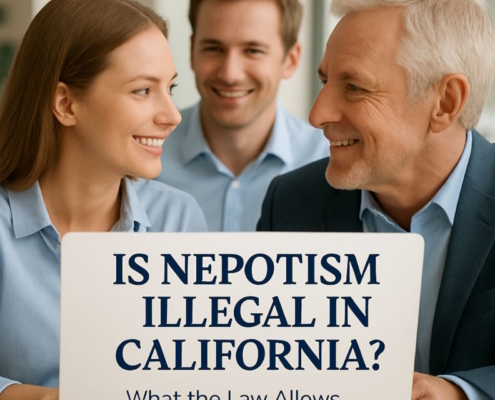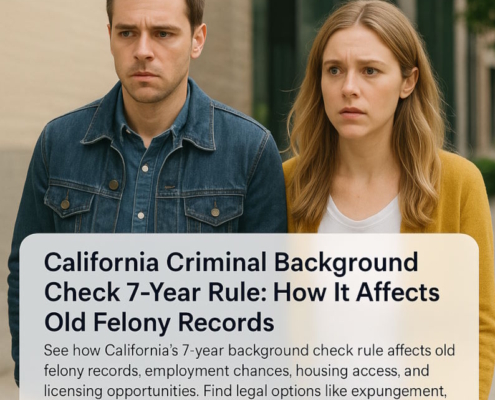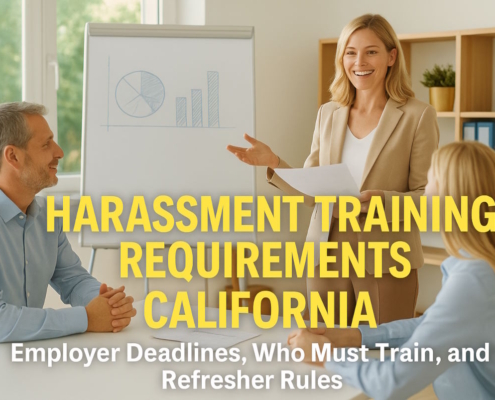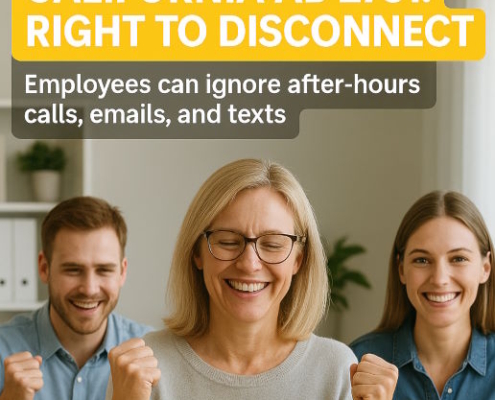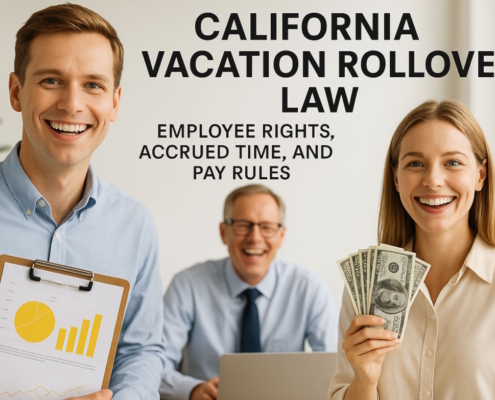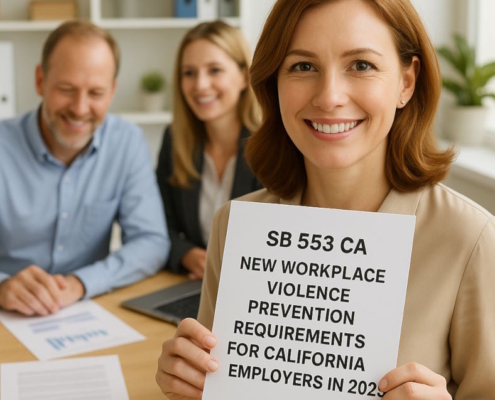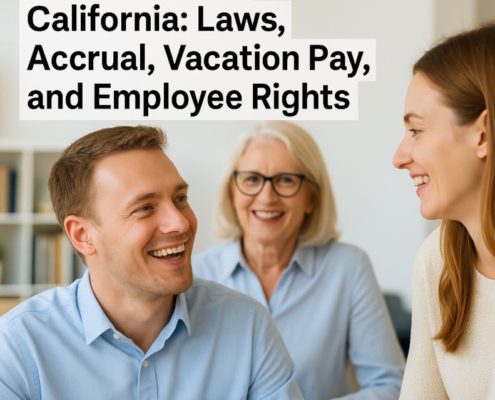Introduction
When someone is fired or laid off in California while performing their lawful job duties and rights or while acting in the public interest, it is known as wrongful termination. This occurs when an employer fires a worker for refusing to break the law or fulfill a job requirement. With the assistance of a California wrongful termination lawyer, an employee can bring a wrongful discharge lawsuit to recover damages.
The definition of wrongful termination, scenarios involving wrongful termination, and a thorough wrongful termination checklist to assist you in understanding what your rights are covered in this guide.
Wrongful Termination: What is it?
Wrongful termination happens when an employer fires a worker in breach of federal/state law. Employees who are asked to leave on discriminatory grounds, including age, disability, or pregnancy status, are also protected by the law in California. Strict employee protection laws also prevent workers from being dismissed for exercising their legal entitlements/rights or performing their legal duties related to important public policy issues in the state. Under California law, a termination may be considered unlawful if the company disregards its own set termination policies or fires employees for illegal reasons.
At-will employment in California
California is an at-will state, meaning that workers and their employers are free to terminate their employment agreement/relationship at any moment without providing any reason. Workers have the privilege to leave their jobs whenever they want, and employers are free to fire employees for nearly any legal cause, unless specifically restricted by an employment contract. The at-will policy, however, doesn’t supersede safeguards against termination for discrimination or any legally protected reasons.
Examples of Wrongful Termination
We will look at several types of wrongful termination in the following paragraphs. To assist you in recognizing possible instances of unfair dismissal at work, we will examine various cases from various industries. These categories serve as a core component of any well-structured wrongful termination checklist.
- Sexual Harassment
Title VII (1964 Civil Rights Act) says that wrongful termination due to sexual harassment happens when an employee is let go for disclosing sexual harassment or for declining unwanted sexual advances at work. Several remedies, such as rehiring, back pay, severe penalties, and reimbursement of legal costs, may follow claims that are successful.
When a retail assistant reports that her supervisor/manager has made explicit remarks about her attractiveness on multiple occasions and has asked for sexual favors in return for better shifts and possibilities for advancement, this is a case of wrongful termination.
You might be able to file a wrongful termination legal action to recover not only monetary damages but also psychological pain and suffering if you endured sexual harassment at work and feel that you were fired as a result of your complaints or quit because you were unable to tolerate it.
- Hostile Work Environment
In a hostile/toxic work situation, wrongful termination occurs when an employee is forced to resign or quit as a result of them reporting/complaining about extreme, pervasive harassment and unlawful discrimination that provokes them not to carry out their regular duties. In some conditions, workers who are wrongly fired may be granted some of the legal instruments, including reinstatement, compensation for lost wages, and penalties for emotional distress.
The companies failing to correct the hostile workplace environments rather frequently experience a weakening of productivity, increased staff turnover rate, and a drop in spirit within the workforce. If conditions at work were bad enough, some employees may feel forced to quit, which could be considered constructive discharge.
- Wrongful Termination: Retaliation for Claims for Workers’ Compensation
When an employer dismisses a worker for pursuing or submitting a claim for workers’ compensation following an accident sustained on the job, this is known as retaliation against workers’ compensation claims. This is against the law in the majority of states and may result in legal recourse for the fired worker.
You can file an unfair dismissal lawsuit against the company if you suffered an injury at work and were let go after attempting to obtain compensation for your injuries because you filed a claim. Employees who participate in a compensation case on behalf of another worker cannot be fired by their employers or threatened with termination. In the past, the courts in California have also decided that it is unlawful for employers to punish workers for missing work because of an injury sustained on the job.
In a similar vein, California law forbids discrimination on the basis of a worker’s disability resulting from an injury sustained on the job. Employers are also prohibited from terminating workers for making use of rehabilitation services provided as a compensation benefit.
- Family & Medical Leave Act violations
Employees who are unwell, need to care for a loved one who is ill, or are bonding with their infant or new baby are eligible for protected leave from work under the Family and Medical Leave Act.
Workers are entitled to return to work and to be unaffected by reprisals for taking time off. For this law to be applicable, companies must employ fifty or more people for at least twenty weeks in a year.
If an employee has served in an organization for at least a year & 1250 hours, they are entitled to leave under FMLA. For the following circumstances, eligible workers may take a maximum of twelve weeks of unpaid absence.
- The birth and upbringing of a newborn.
- Taking care of a foster or adopted child.
- Providing medical attention to a family member with a serious illness.
- If a medical issue that the employee has keeps them from performing their duties.
- To give medical care to an active member of the military service who is being treated due to a serious illness or injury.
There is a possibility that you can bring a wrongful termination lawsuit against the company in case you were fired after you took medical or family leave to which you are entitled. In order to find out more about how to protect your legitimate rights, refer to an experienced California employment attorney.
- Wage & Hour Dispute
A worker may be entitled to damages & reinstatement if their employer fires them for voicing concerns about wage & hours issues. This could include unpaid pay, overtime breaches, or other compensation difficulties. This is a type of “wrongful termination,” which is illegal. You have the right to sue your employer for wrongful termination if you were finding it tough to get overtime, commissions, or unpaid wages and were dismissed as a result. Issues regarding wages & hours can be frightening and complicated. However, both federal and California laws provide you with legal safeguards as an employee.
Wage & hour breaches are quite common. Breaches could include not providing the minimum wage, denying workers breaks for meals or rest, failing to pay overtime as mandated by labor regulations, and misclassifying workers.
Gathering supporting paperwork is always beneficial. Keep a full record of pay stubs, contracts of employment, company regulations, schedules, etc., if you are bringing a wrongful termination case over wage & hour violations. Such records can support your argument and provide important proof.
- Whistleblower Retaliation
Sometimes, a worker can get fired by the company for reporting unlawful activity, regulatory infractions, or any other wrongdoing to management/authorities. This is considered whistleblower retaliation. It is totally against whistleblower safeguards provided by law and may result in serious legal repercussions for the employer. You can file a wrongful termination lawsuit if you exposed your employer’s unlawful behavior/operations and were dismissed as a result. Examples of wrongful termination cases are provided below to provide a clearer illustration.
If you told the company’s HR department about sexual harassment at work and were dismissed shortly after, it’s likely that the company fired you in retribution for exposing the harassment.
Additionally, you might have been unlawfully fired if you were let go after reporting illegal activities at work, such as fraud, safety violations, etc. When evaluating whistleblower infractions, an employment lawyer can find evidence that could otherwise go unnoticed.
- Violation of The Worker Adjustment and Retraining Notification Act
In wrongful termination instances, covered employers violate the California WARN (Worker Adjustment and Retraining Notification Act) when they perform mass layoffs, changes in location, or terminations at covered businesses without giving at least Sixty days’ notification in advance. Compared to its federal counterpart, the WARN Act is enforced more rigorously and has fewer exceptions. Employers who infringe it risk civil penalties of as much as $500 per day and liability for back wages and fringe benefits for the duration of the violation, for a maximum of sixty days.
If a California tech company, for instance, closes its office and fires 60 workers with only two weeks’ notice, it may be liable for civil penalties and a further 46 days’ worth of benefits and salary for each employee for not meeting Cal-WARN’s sixty-day notification requirement.
- Contract Breach
A contract breach happens when a company fires a worker in violation of the terms stated in an employment contract/agreement. The contract may be written, implied, or verbal. The nature of employment as outlined in the employment contracts would normally include certain terms on the duration of employment, under what terms the employment can be ended, and it would certainly contain provisions on procedures which must be followed before the termination, such as progressive discipline or severance plans.
When employers fail to meet these obligations as stipulated in the contract, dismissed employees can sue to obtain damages. It includes wage loss, benefits, and, in certain situations, specific performance that requires reinstatement.
In most cases, courts look at the terms of the contract, the reasons for the dismissal, and whether the company operated in good faith when assessing whether a violation of contract took place. A university lecturer with a three-year contract, for instance, may have a legitimate breach of contract action against the educational institution if they are fired midway through the period without providing the documented justification specified in their agreement.
- Prejudicial Treatment of a Protected Group
A protected class is discriminated against when an employer terminates a worker because they belong to a legally protected group, such as:
- Race
- Color
- Sex
- Religion
- National Origin
- Age
- Disability (mental or physical)
- Genetic information, and more
These discriminatory expulsions tend to follow a pattern. Employer harasses the protected worker and treats them differently from colleagues in similar circumstances. They are denied chances that others have access to. Employer fabricates excuses for termination that conceal discriminatory intent.
Prior to bringing a lawsuit, victims can ask for remedies from the Equal Employment Opportunity Commission or state agencies. Remedies could be reinstatement, front pay, back pay, compensatory damages, and punitive penalties in circumstances of willful abuse.
A computer engineer aged 60 is let go during “restructuring,” whereas younger workers with fewer abilities and worse performance reviews are kept on board and even promoted. This may have a strong case for age discrimination.
- Discrimination during Pregnancy
All companies in California are to abide by the Pregnancy Discrimination Act (1978) and other state & federal provisions. They can’t fire an employee merely because the employee is pregnant, recently gave birth, or has a medical condition related to pregnancy or childbirth. This is known as pregnancy discrimination. This type of discrimination often takes the shape of unfavorable employment actions despite excellent job performance. Employers negatively assume a pregnant employee’s talents, availability, or devotion to work.
Due to an established pattern of discriminatory treatment, many pregnant workers who were wrongly fired describe abrupt performance reviews, fewer hours worked, or restrictions on work chances after disclosing their pregnancy. Apart from the back pay and reinstatement, victims may also get punitive damages, compensatory damages, & reimbursement for legal expenses. It all depends on the jurisdiction and particulars of the case.
A California pregnancy discrimination lawyer would probably have a strong case for a store manager who was fired soon after announcing her pregnancy, for instance, even though she had received years of good performance feedback and her supervisor had told her that “customers do not wish to observe pregnant females on the sales floor.”
- Racial Discrimination
Race discrimination is observed when an employee is let go because of their race, skin color, ethnicity, or any other racial traits. This is against the Civil Rights Act (Title VII). According to laws enacted by state & federal governments, it is strictly forbidden for any worker to be treated unfairly/badly due to their ethnicity or skin color. It can result in victims receiving damages, reinstatement, and back pay.
Segregating workers of a particular race/ethnicity in specific positions is not allowed. Using race/ethnicity as a factor in recruiting, firing, and promoting staff is strictly prohibited.
The worker has a strong case for wrongful termination if such discriminatory actions make the workplace uncomfortable or if they were fired for reporting/exposing racial discrimination.
- Public Policy Violation
Employers who terminate workers for reasons that go against defined public policy, like refusing to commit crimes, exercising their legal rights, carrying out civic responsibilities, or reporting infractions of laws intended to safeguard the public interest, are in violation of public policy.
This legal theory is a restriction on employment at will because it recognizes the fact that employers cannot be allowed to take advantage of their financial power in coercing employees into carrying out acts that contravene basic social rules or any other laws enacted to serve the common good of the people. Courts follow the requirement that the breached public policy must be clearly expressed in legislation, in constitutions, in administrative rules, or in judicial conclusions.
Restitution, back pay, monetary compensation for emotional anguish, and, in extreme situations, punitive damages are all possible responses to a breach of public policy. For instance, a truck driver who is dismissed for reporting safety problems to the Department of Transportation or for refusing to go over the legally authorized limit of driving hours is probably going to have a solid case for wrongful termination.
- Breach of Company Policy
Employers who terminate workers in ways that deviate from the company’s own rules, processes, or handbooks for employees that set reasonable expectations for working conditions and termination procedures are in violation of the company’s policies.
In many cases, these internal policies define performance improvement actions, progressive discipline actions, or a very exact cause of the termination, despite most states regarding employment as at-will, which can expose the company to a lawsuit in case they are neglected. Policy manuals or employee handbooks containing specific assurances or even particular procedures regarding job security and termination procedures may be treated by courts as bearing implied contractual responsibilities limiting the freedom of an employer to terminate workers without cause.
Remedies would fall under the domain of back pay, reinstatement, or even compensation for emotional anguish, considering the jurisdiction and the details of the case. As an example, a retailer, whose employee was easily dismissed on the account of one mistake in handling cash, might have a good wrongful termination case, because by dismissing the employee immediately, the organization has violated its own policies. As directly stated in the handbook, one mistake should lead to the three-step gradual discipline process (verbal warning, written warning, and dismissal).
Wrongful Termination Checklist
You need to review this wrongful termination checklist to assess if your rights may have been violated:
- Was it an unfair workplace or sexual harassment that made me leave?
- Was my race the reason for my termination?
- Was I let go because I filed a workers’ compensation claim?
- Did I lose my job because I took a family leave?
- Is my demand for unpaid wages the reason I was fired?
- Has the termination followed your complaint of harassment/discrimination?
- Has your boss/supervisor given you a written reason as to why you were fired?
In case you are considering/planning on filing a claim, this wrongful termination checklist can be of great help. With its help, you can formally write down harassment, retaliation, or a breach of agreement.
Wrongful Constructive Termination
When a worker is forced to leave their position because their employer made it impossible for them to remain, this is known as wrongful constructive termination. The employee must demonstrate that the employer willfully established an “intolerable” workplace or permitted working conditions to deteriorate to the point where a reasonable employee would resign as a result of them in order to bring a wrongful constructive termination claim.
Claims for wrongful constructive termination may also be brought in situations where an implied agreement or public policy would have prevented the employer from having a valid reason for terminating the staff member in question.
How to find out if your termination was wrong
It’s mostly pretty clear when you have been fired unfairly. There is a solid chance that you have been illegally terminated if your answer is “yes” to any of the following questions.
- Did any protected trait/characteristic (age, race, religion, disability, etc.) lead to your termination?
- Did having to go on family leave cause you to lose your job?
- Did you have to leave your job because the sexual assault you encountered there was intolerable?
- Did you submit a workers’ compensation claim and then lose your employment shortly after?
- Did your request to the employer/manager to pay your due salaries result in your termination?
- Did you report/expose your employer’s unethical/illegal conduct to the government, which led to your termination?
Use the questions above in addition to your wrongful termination checklist to evaluate your case.




